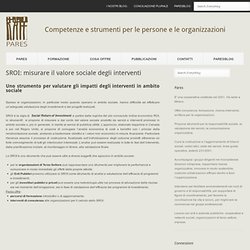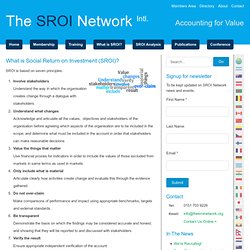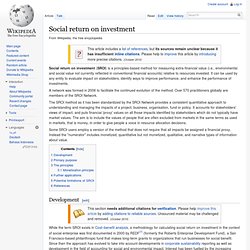

Contextinternationalcooperation.files.wordpress.com/2010/11/sroi-practical-guide_context-international-cooperation.pdf. Come misurare lo SROI. The Problem with SROI. Many who love the concept of SROI thrill to the vision of a universal performance measure that places human and environmental well-being on par with financial wealth….

Or to the vision that do-gooders might really be able to account for their performance…. Or that philanthropic money might be allocated against more objective criteria…. Or that SROI could be compared directly with financial ROI to reveal a new, sustainable “efficient frontier”…. Or that SROI will reveal the financial returns driven by social investments…. Whichever particular vision it is, they love SROI! On the other hand, many of those who dislike it can’t stand that it implies that you could sum up all that is of value into a single, quantitative ratio…. Many of us, however, see a middle ground: that SROI in practice may provide a coherent underlying architecture on which to build processes and tools that help organizations manage the social returns of their investments in a hands-on way. SROI - Primer. SROI: misurare il valore sociale degli interventi. Uno strumento per valutare gli impatti degli interventi in ambito sociale Spesso le organizzazioni, in particolar modo quando operano in ambito sociale, hanno difficoltà ad effettuare un’adeguata valutazione degli investimenti e dei progetti realizzati.

SROI è la sigla di Social Return of Investment: a partire dalle logiche del più conosciuto indice economico ROI, lo strument0 si propone di misurare e dar conto del valore sociale prodotto da servizi e interventi promossi in ambito sociale o, più in generale, in merito ai servizi di pubblica utilità. L’approccio, elaborato dapprima in Canada e poi nel Regno Unito, si propone di coniugare l’analisi economica di costi e benefici con i principi della rendicontazione sociale, andando a trasformare obiettivi e i valori non economici in misure finanziarie. Particolare rilevanza assume il processo di costruzione, focalizzato sull’individuazione degli outcome prodotti attraverso un forte coinvolgimento di tutti gli interlocutori interessati. What is SROI - The SROI Network. What is Social Return on Investment (SROI)?

SROI is based on seven principles: These principles are core to SROI and how it should be used. However, in encouraging consistency of models, the SROI Network is in discussion with practitioners who use related tools to see if principles can be aligned and agreement established on measuring social impact. Therefore, these principles and how they are expressed may be revised.
SROI is an approach to understanding and managing the value of the social, economic and environmental outcomes created by an activity or an organisation. SROI seeks to include the values of people that are often excluded from markets in the same terms as used in markets, that is money, in order to give people a voice in resource allocation decisions. If you are producing a report of your SROI, we recommend that you have the report assured. Go to the SROI Guide documents Why are the principles so important? Principles are important because: The SROI Network. Social return on investment. Social return on investment (SROI) is a principles-based method for measuring extra-financial value (i.e., environmental and social value not currently reflected in conventional financial accounts) relative to resources invested.

It can be used by any entity to evaluate impact on stakeholders, identify ways to improve performance, and enhance the performance of investments. A network was formed in 2006 to facilitate the continued evolution of the method. Over 570 practitioners globally are members of the SROI Network. The SROI method as it has been standardized by the SROI Network provides a consistent quantitative approach to understanding and managing the impacts of a project, business, organisation, fund or policy. It accounts for stakeholders' views of impact, and puts financial 'proxy' values on all those impacts identified by stakeholders which do not typically have market values.
Development[edit] Primary purpose[edit] The principles[edit] Monetisation principle[edit] References[edit]